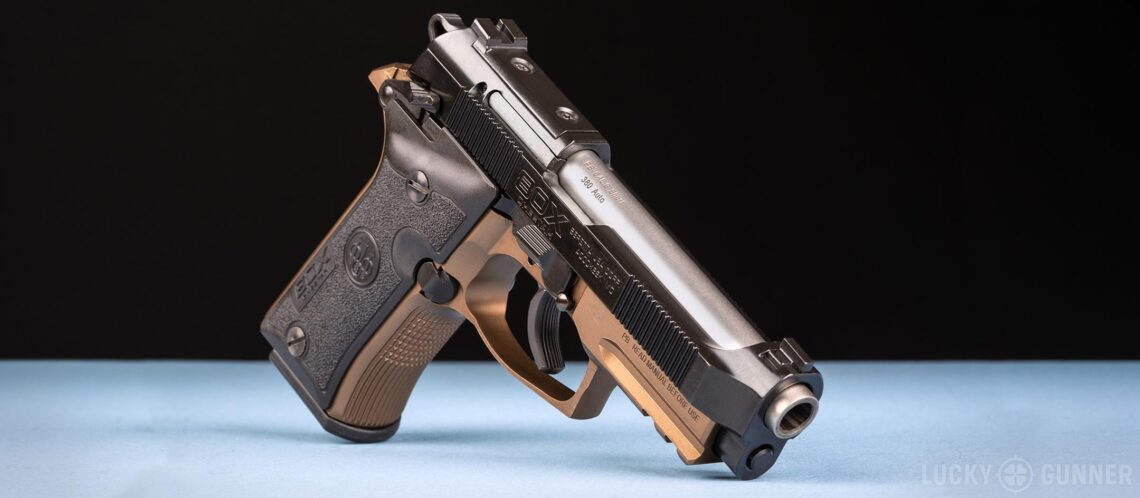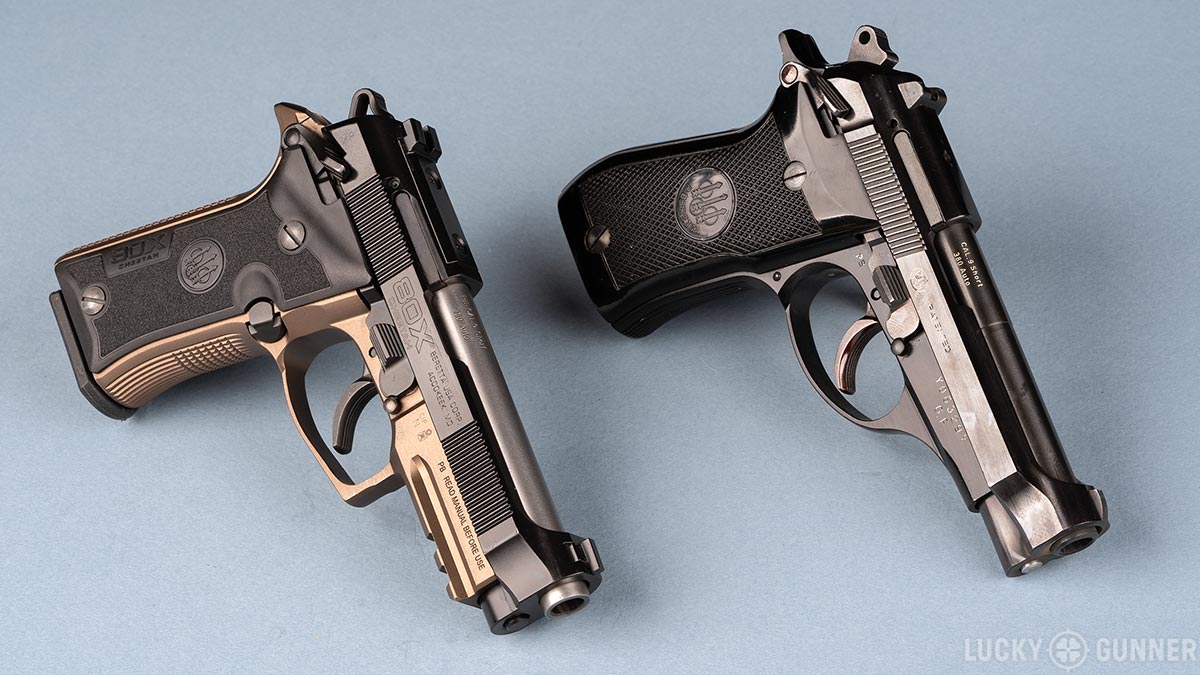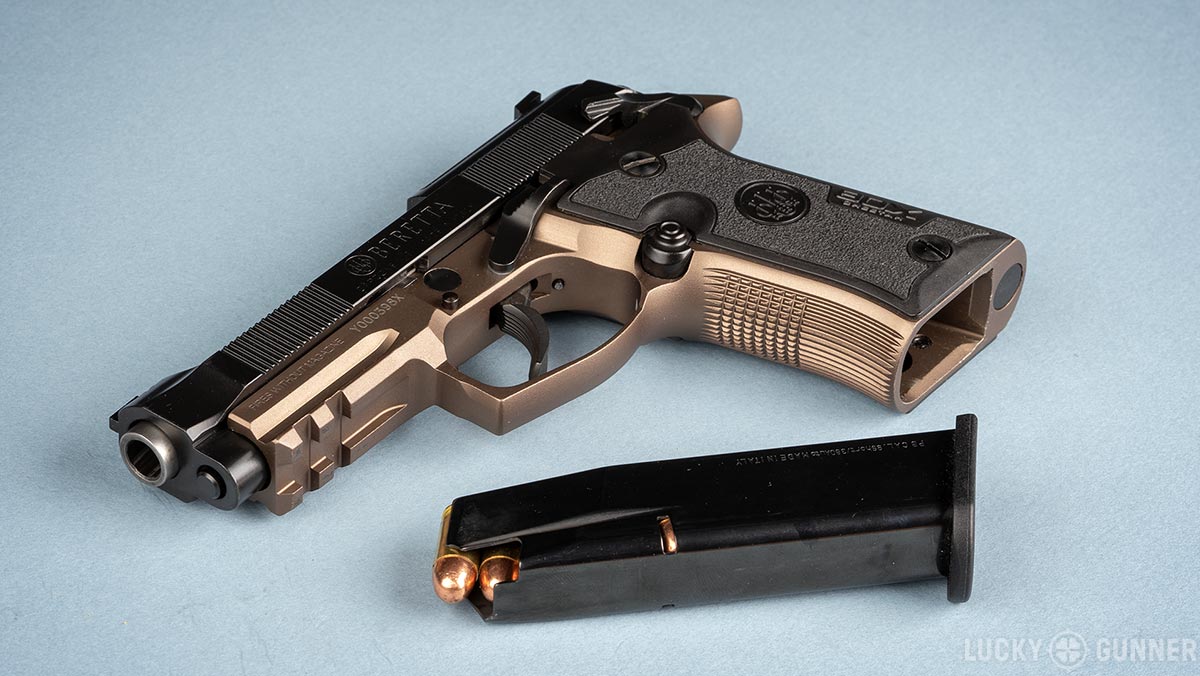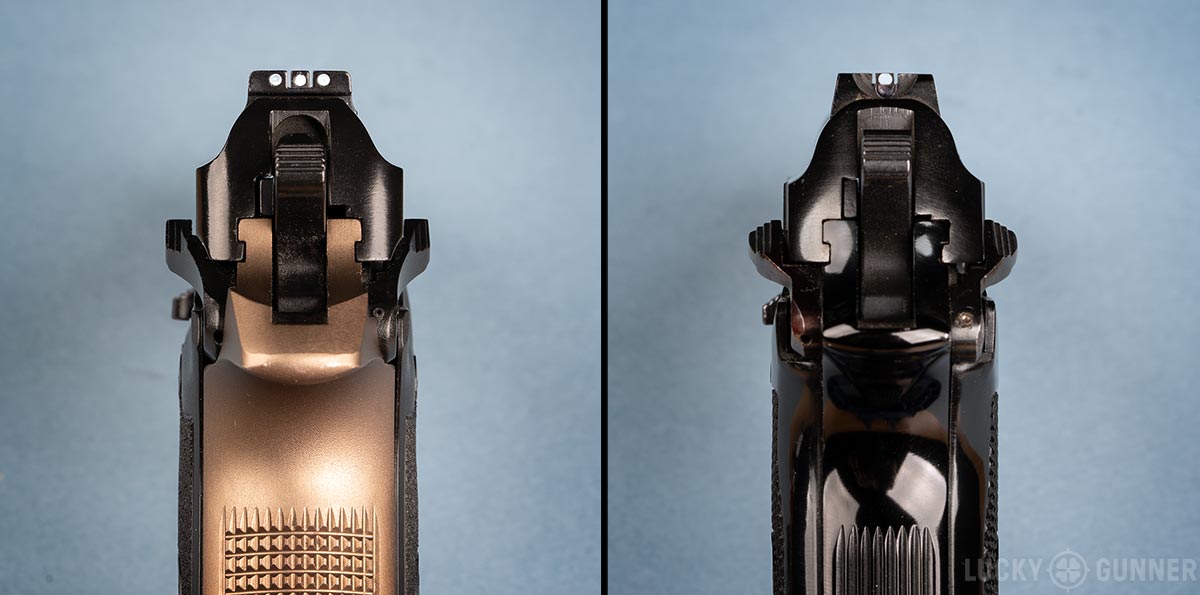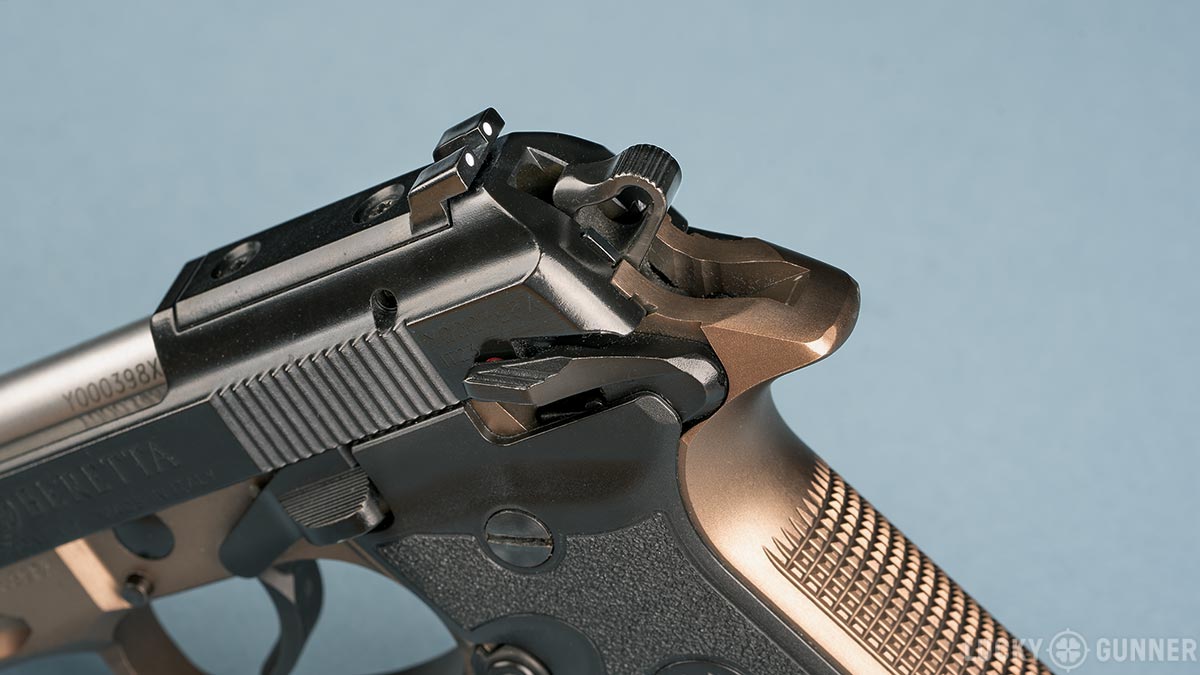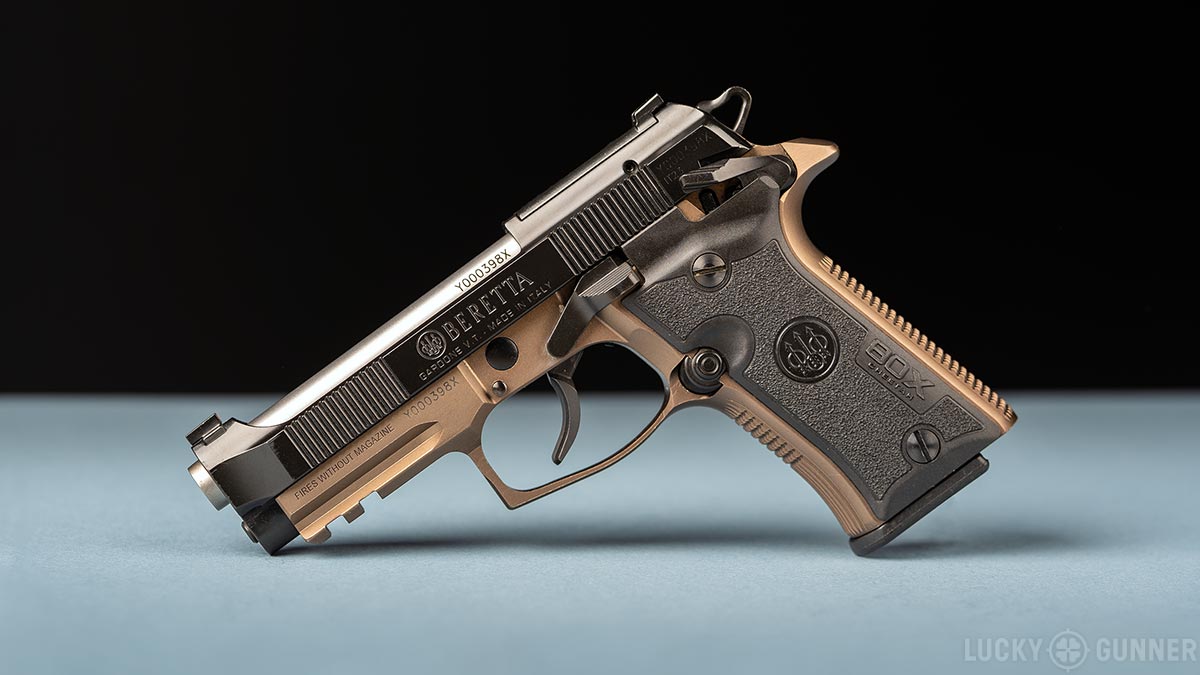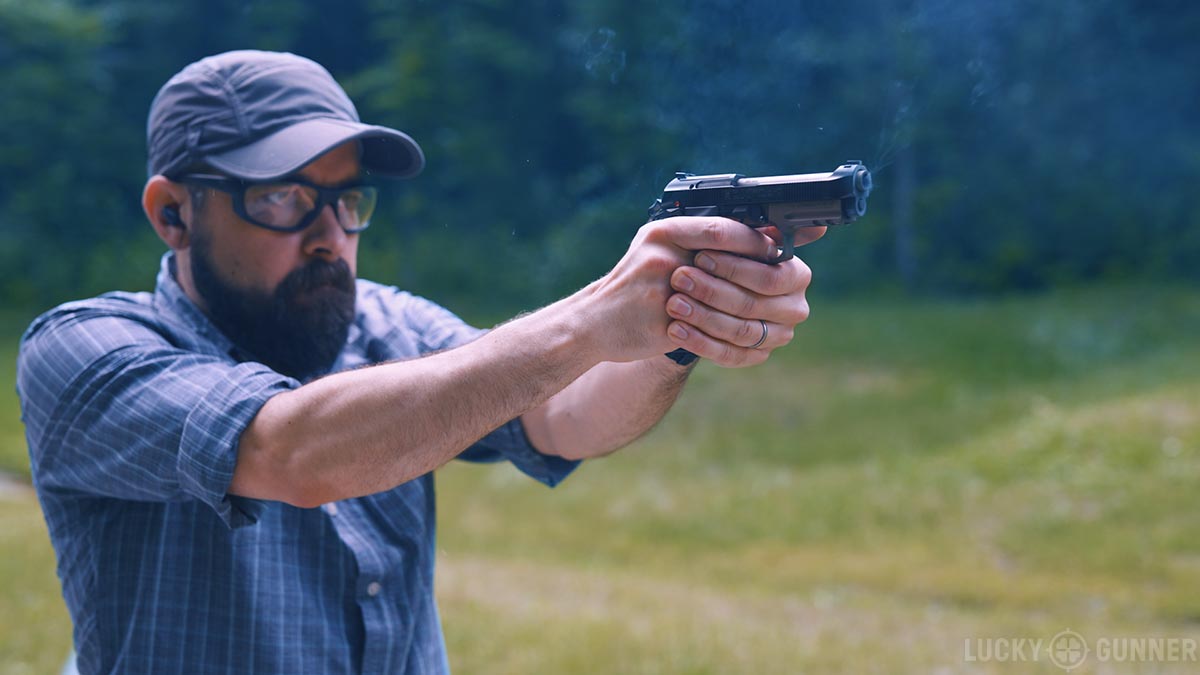When I first heard Beretta was planning to release an updated version of the classic 80-series Cheetah pistol, I was cautiously optimistic. I assumed they would add an accessory rail, which would undoubtedly spoil the clean lines and minimal bulk of the original design. And I was sure it would only be offered in .380 ACP, rather than the far more interesting (and fun) .32 ACP.
Turns out I was not wrong on either account. But once I got over that initial knee-jerk reaction, I warmed up to some of the more promising new features of the Beretta 80X and decided I had to try one for myself.
Details are in the video below, or keep scrolling to read the full transcript.
Hey everybody, I am Chris Baker from LuckyGunner.com and today I’m going to review the new Beretta 80X Cheetah – a unique concealed carry option that’s a fusion of old and new.
I’ve run about 1200 rounds through this pistol over the last couple of months. We’re going to look at the basic specs and features, and I’ll tell you what I think of it so far.
The Basics
The Beretta 80X is an updated version of the classic 80-series Cheetah that was in production from the mid 1970s until just a few years ago. The new Cheetah is the same basic design as the original, but with a number of improvements and modern features.
I’m a huge fan of the original Cheetah series. In particular, the old Model 81 is among my all time favorite pistols. That’s the double stack .32 ACP variant. The 80X is a double stack in .380 ACP, so it’s more analogous to the old model 84. I have a video from a couple of years ago dedicated to the Cheetah series and its history in case you want to learn more about the roots of the new 80X.
Like the old version, the new Cheetah is a straight blowback (or simple blowback) operated pistol with a lightweight aluminum frame and steel slide. It’s a hammer-fired double action/single action design with an ambidextrous frame-mounted safety/decocking lever. The double stack magazine holds 13 rounds. It’s got a 3.9-inch barrel and a fully loaded weight of 28 ounces. The 80X that Beretta loaned us for this review is the special launch edition variant with a bronze frame and stainless barrel. The standard version is all black, and Beretta has hinted at the possibility of other color variants in the future.
This style of pistol is very much a vestige of the 20th century. It’s compact, but large compared to modern .380 pistols. It’s hammer-fired with an all-metal construction. It might seem dated, but that also comes with a “they don’t make them like they used to” kind of quality.
The Cheetah was originally designed as a sidearm for military and police, primarily in Europe, Asia, and South America. That means it’s literally a duty-grade pistol that just happens to be chambered for a smaller cartridge. In that respect, it’s similar to other foreign surplus pistols like the Makarov or the CZ-83. The 80X combines that built-to-last legacy with modern features. Which I will tell you about. Starting now.
New Features
The most obvious feature Beretta added that was not present on the old Cheetah is the accessory rail. They also added checkering to the front and backstrap. They’ve re-contoured the backstrap to have a straight profile just like the Vertec grip variants from the 92 series.
As the lawyer mark on the frame reminds us, the Beretta 80X will fire without a magazine. The later variants of the classic Cheetah do have a magazine disconnect safety. That’s a fairly unpopular feature in the commercial market, so it was probably a good move for Beretta to get rid of it.
Sights
The iron sights were one of the weakest features of the old Cheetahs. They were just too small, and the integral front sight could not be changed. The 80X now has a dovetail front sight, so you can swap it for another option when they become available. The slide is also optics-ready. The optic cut comes from the factory with an integral rear sight plate installed. We were not able to get an optic adapter plate in time for the review. But as of now, Beretta does have plates for several different optic footprints available on their website.
The factory iron sights are only marginally better than those on the old Cheetah. They’re still on the small side with a basic three-dot configuration. Of course, I blacked out the rear dots and put some orange nail polish on that front sight to make it easier to track. Hopefully at some point, Beretta will offer some larger irons with a high visibility front sight.
Magazines
Beretta made some changes to the magazine design for the new 80X, supposedly to improve reliability with hollow point ammo. Some of the early press on the 80X said that it was not compatible with the old Model 84 magazines. It turns out that is not the case.
We’ve been using four MegGar mags designed for the 84 interchangeably with the two mags that came with the 80X. I can’t tell any difference without looking at them, and they’ve all run without any issues. I’d say they’re good to go, as long as you’re shooting FMJ.
Trigger
In my opinion, the best change Beretta made to the 80X is the one you can’t see – the trigger pull. The original Cheetah has a pretty mediocre trigger. It’s not bad, the double action is just a bit heavy.
I don’t know how Beretta re-engineered the trigger for the 80X, but it’s a massive improvement. The double action on this one is a smooth 6.5 pounds. It fires from a half-cock position, so there’s a lot of slack and then a short length of travel. The single action is a crisp 4.5 pounds – a little on the heavy side, but good for a carry gun. The double action more than makes up for it – it’s one of the best factory triggers I’ve encountered.
Safety/Decocker
The action functions more or less the same as the later classic Cheetahs. To load the gun for carry, I’d insert the mag and move the safety down to the fire position so I can rack the slide. Now the hammer is cocked and the safety is off.
Unlike the early 80-series pistols, the 80X cannot be carried cocked and locked. The safety feels like it has a middle position here, but that actually doesn’t do anything. Some samples of the 80X appear to disable the trigger when the safety is in this middle position, but Beretta has verified that this is not an actual safe position. On this 80X, I can still pull the trigger and the firing pin is not disabled. It’s not safe to carry like that.
Instead, push the safety all the way up, which decocks the hammer. Now it’s in the half cock position and the trigger is disconnected. You can carry it with the safety on or off as long as it’s decocked first.
The safety comes off with a very positive and distinct click. For my hands, the safety is in an ideal position where I can intuitively flip it down when I grip the gun.
The decocker is a little stiff. I’d like to be able to decock with the knuckle of my thumb, but that’s kind of awkward to do. I usually use my left thumb to decock at the range.
Field Stripping Tip
Field stripping the 80X is pretty straightforward, but I want to show you one little quirk that can drive you crazy if you don’t know about it. To disassemble the gun, first make sure it’s not loaded – no mag, chamber is clear. Then, with the safety off, press and hold the release button on the left side of the frame. That will let you rotate the disassembly latch down and forward. Then the slide comes right off. The guide rod and barrel come out like normal and that’s it.
To reassemble, put everything back in the slide the way you found it. Put the slide back on the frame, pull it all the way back and lock it in place with the slide stop. You don’t have to pull it all the way back, but it’s easier to demo that way. Now you just have to rotate the takedown lever back. But right now, it doesn’t want to move, even if I press the release button. What I have to do is press the lever forward a little and hold it there. That will let me move the barrel back about a quarter inch. Now when I release the lever, it will pop back to its original position. Close the slide, decock, and you’re done.
Holster Fit
Because of the accessory rail, the 80X will not fit in most holsters designed for the original Cheetah. Honestly, that’s not really a big deal, because it’s almost impossible to find a decent holster for the classic Cheetahs anyway. Fortunately, Beretta already has some big name holster makers on board for the 80X. You should be able to find some of those soon, if not now.
An old Cheetah might fit in an 80X holster. My 81BB kinda fits in this 80X holster with a little room to spare. An F or FS model might fit better because they have the square trigger guard like the 80X
By the way, this is a pre-production sample of the 80X Enigma Express that PHLster sent us. The finished version should be available very soon. If you’re not familiar with the Enigma, it’s a kydex holster system with an integrated belt. I’m using the optional sport belt that’s wider than the original with a little extra cushioning. I’ve also got this aftermarket sleeve called the Papoose from Levo Designs.
I’ve said it before, but the Enigma is an absolute game-changer for concealed carry. This setup is actually more comfortable in a lot of ways than carrying a 12 ounce snub nose in a conventional belt holster. It works with or without a belt or whether my shirt is tucked or untucked.
Straight Blowback Design
The 80X is blowback operated which has some advantages and disadvantages. Almost all new semi-autos are locked breech or short recoil operated. That gives the shooter less felt recoil than blowback pistols, as we saw in the high speed footage from our last video. Straight blowback pistols have a very fast recoil impulse that tends to feel kind of snappy. (Check out this video for a detailed explanation of the difference between straight blowback and locked-breech/short-recoil operated pistols.)
The plus side is that blowback designs are often more reliable. .380 ACP just barely has enough pressure to operate a locked breech system. It tends to work okay on pocket pistols where the slide weighs basically nothing. When you move up to the slightly larger class of .380s like the Glock 42 or the P365-380, reliability is kind of borderline. Those pistols really depend on the shooter to have a firm grip high up on the backstrap in order to cycle completely.
That has some implications for novice shooters and people with diminished grip strength. Even experienced shooters often end up with an awkward or compromised grip on the pistol during the stress of actual life-threatening situations. That’s exactly the kind of error that can cause a malfunction in a locked-breech .380.
The Cheetah’s straight blowback design is generally much more forgiving. It doesn’t really care how you grip it as long as the slide can move freely. It’s an inherently reliable design for a gun of this size and caliber. There’s a little recoil, but it’s less than a similar sized 9mm.
Reliability
The reliability of this 80X sample has been exemplary. I’ve fired about 12 to 1300 rounds through the Cheetah, including a couple of training classes. Almost all of that has been full metal jacket ammo. I’ve only experienced two stoppages – both failures to feed, which I’m going to say were due to operator negligence.
Blowback pistols tend to get dirty a lot faster than locked breech guns. Both times the gun malfunctioned, it had not been cleaned in at least 400 rounds. In both cases, the slide stopped with the cartridge partially in the chamber and then closed after I tapped the bottom of the magazine. Just be sure to give it a quick cleaning every couple hundred rounds or so, and the 80X should run just fine.
Ballistics
There are sure to be complaints that the new Cheetah is still “only” a .380 and not 9mm. That’s just the nature of the design. 9mm is simply not possible in a straight blowback gun this small. It would have to be a locked breech or some other system. And then it would be a completely different pistol that would have to be designed from the ground up.
So .380 is what we’ve got, and there’s nothing wrong with that. This gun is easy to shoot reasonably well, and that’s what really matters. .380 ammo does cost about 50% more than 9mm, so I understand if that gives you pause. But I wouldn’t lose sleep over the ballistics of .380 ACP.
In terms of ammo selection, I would stick with full metal jacket for carry. I know we had one or two .380 hollow points that performed okay in our gel tests from a few years back. The penetration was still marginal at best. Even with the longer barrel in the Cheetah, you just can’t get .380 that both penetrates and expands like a true service cartridge. But penetration is more important by far and full metal jacket .380 will do that just as well as 9×19.
Performance
There are very few small, concealable options for fans of double action. Even fewer that are actually in current production with modern features. If you’re looking for that Goldilocks balance of easy to shoot, easy to carry, features, and magazine and holster support, the Beretta 80X is, hands down, the best DA/SA out there for everyday carry.
But the Beretta 80X is begging to be more than just a carry gun. The trigger and the overall feel of this pistol can trick you into thinking you’re shooting a high-performance gun made for beating all your personal records.
And that’s actually why I’ve been a little frustrated with it. I’ve shot a lot of drills and tests with the 80X, and I always feel like I’m on the edge of accomplishing some great feats of speed and marksmanship. But a couple of issues have been holding me back.
First is the sights, which I mentioned earlier. They’re too small, too hard to see when you’re going fast. The bigger issue for me is the backstrap. It does not fill my hand as well as the rounded backstrap on the original Cheetah. I have trouble getting an optimal firing grip when I draw from the holster. I can’t grip it as hard as I would like. There’s more room for the gun to shift in my palm so I get more felt recoil. I’m really hoping Beretta will release wraparound grip panels that mimic the shape of the original Cheetah grip.
While I’m working on a wish list, I would also love to see conversion kits for .22 LR and .32 ACP with threaded barrels. The original Cheetah was chambered in both of those cartridges, so I don’t feel like that’s too unreasonable to ask for.
In any case, I’m just happy that Beretta is giving some attention to the Cheetah to begin with. When they let the old Cheetah quietly slip out of their catalog a few years ago, I figured that was the last time we would see new Cheetahs. So the release of the 80X was a welcome surprise. This is probably not the last time you guys will see me with this gun. I’ll try to keep you updated. In the meantime, don’t forget to check the cabin air filter in your car. I bet that thing is disgusting. And don’t forget that you can always get your ammo from us with lightning fast shipping at LuckyGunner.com.
